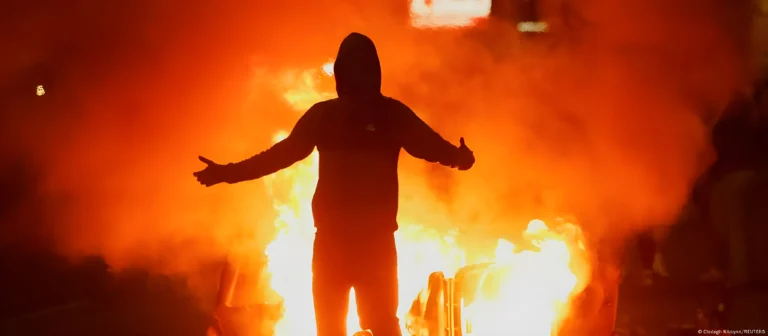Anti-Immigrant Demonstrations in Northern Ireland and Spain: Causes, Consequences, and Challenges for Coexistence

July 22, 2025 Hour: 8:25 am
Migration is a phenomenon as old as humanity itself. Since prehistoric times, humans have migrated in search of food, better climatic conditions, safety, and basic resources.
However, throughout history, the reasons and forms of migration have evolved: territorial conquests, world wars, internal conflicts, and economic crises have been driving forces that push people to leave their homes in search of better opportunities or protection.
Today, migration remains a dynamic and complex process that impacts societies across all continents and generates tensions in host countries.
According to the International Organization for Migration (IOM), by 2020, there were 281 million international migrants worldwide, representing 3.5% of the global population.
Of this total, 135 million were women, and 28 million were children. In 2019, 169 million migrants were registered as active workers, highlighting the economic significance of human mobility in today’s globalized system.
By 2022, the number of displaced people worldwide rose to 117 million, driven by armed conflicts, persecution, violence, or disasters. Despite these figures and the realities they represent, migration is not always accepted in destination countries; it often generates tensions and friction between locals and foreigners, exacerbated in contexts of social, economic, or political crises.
The Stigmatization of Migrants: Origins and Consequences
In host societies, migrants are frequently blamed for unemployment, rising crime, overcrowded public services, or the supposed degradation of local customs.
These prejudices are often exploited by populist political movements, particularly far-right groups, which construct anti-immigration narratives and mobilize broad sectors of society.
Thus, it is not uncommon to witness protests, such as those recently seen in Northern Ireland and Spain, where radicals organize demonstrations and riots for several days.
This article provides an in-depth analysis of the causes and consequences of the most recent anti-immigrant protests in Northern Ireland and the Spanish town of Torre Pacheco, as well as the factors fueling this phenomenon and potential solutions to promote social coexistence.
What Are Anti-Immigrant Protests, and What Motivates Them?
Anti-immigrant protests are collective expressions of rejection or opposition to the presence of migrants. These demonstrations are motivated by political and economic factors, cultural fears, and, at times, concerns over public safety.
While they may begin peacefully, they can escalate into violence, often arising in contexts of economic crisis, demographic changes, or social conflicts.
The most common arguments revolve around phrases like “they take our jobs”, “they saturate public services”, “they threaten our culture”, or “they increase crime”.
These messages, though widely repeated, contrast with the evidence: numerous studies show that, in the long term, migration positively contributes to the economy and that culture is, by definition, dynamic and transformative.
Hostility toward migrants, manifests in various ways: street protests, attacks on communities or refugee centers, stricter immigration laws, and hate campaigns on social media and in the press.
Such discourses and actions not only fuel discrimination and violence but also strengthen extremist parties and promote exclusionary policies.
Additionally, they pose a serious risk of human rights violations, such as mass deportations or forced family separations.
This phenomenon has been extensively documented, including in a 2022 book by Isabel Ortiz, Sara Burke, Mohamed Berrada, and Hernán Saenz Cortés, which analyzes the growing proliferation of populist protests, particularly from the far right, aimed at restricting the rights and equality of groups perceived as threatening, such as migrants.
In recent years, these protests have increased, threatening social cohesion, especially in complex historical contexts.
Northern Ireland: A History of Divisions and Renewed Tensions
Northern Ireland has a long history marked by social tensions and divisions. Since the partition of Ireland in 1921, the country has been split between a Protestant unionist majority and a frequently discriminated-against Catholic minority.
The 1960s saw the rise of a civil rights movement for Catholics, which was harshly suppressed and led to an armed conflict between nationalists and unionists, leaving approximately 3,500 dead.
Although the peace process initiated in the late 1990s ended armed violence, the social fabric remained fractured.
This deep historical divide shapes the local population’s attitude toward migrants and minorities today. Distrust and hostility persist, while racist attacks, particularly against Romani, African, and Asian communities, have increased.
Extremist groups, such as loyalists, have carried out attacks on migrant homes and contributed to a rise in hate crimes. Politically, parties like the DUP (unionist) and Sinn Féin (nationalist) use identity narratives to garner support, exacerbating fears and polarization.
In June and early July 2025, towns like Ballymena, Portadown, and Coleraine became scenes of violent anti-immigrant protests, triggered by an accusation of sexual assault involving two teenagers who required a Romanian interpreter during legal proceedings.
This incident was quickly exploited by radical movements, which directed public outrage toward the immigrant community. The riots included property attacks, arson, clashes with police, and symbolic anti-immigrant bonfires during unionist marches.
The result: displaced families, multiple injuries, and severe material damage. Despite public condemnation from authorities, including British Prime Minister Keir Starmer, and police intervention with numerous arrests, fear and division persist, threatening Northern Ireland’s already fragile cohesion.
Torre Pacheco, Spain: Immigration and Conflicts in the Agricultural Sector
Torre Pacheco, an agricultural municipality in Spain’s Murcia region, illustrates how migration-related tensions can emerge even in communities economically dependent on foreign labor.
Fruit and vegetable harvesting requires a significant workforce, over 80% of whom come from the Maghreb, mostly Moroccans, numbering around 6,000 residents.
This reality has fostered years of effective labor integration, though many migrant workers, especially young people, still face precarious living conditions and high marginalization rates.
On July 8, 2025, Torre Pacheco was shaken by the assault of a 68-year-old resident by three young men of Maghrebi origin.
The spread of the incident, and viralized images on social media, sparked widespread outrage and a call for a gathering in the town square.
However, far-right groups seized the opportunity to spread xenophobic messages and mobilize outside followers, overwhelming the initial protest and turning it into violent riots that lasted three nights, particularly in the San Antonio neighborhood.
Attacks on property, object throwing, chases targeting Maghrebi immigrants, and a generalized climate of fear resulted in minor injuries and eight arrests.
The migrant community, particularly Moroccans, reported feeling terrified and unprotected as police struggled to contain the unrest. Authorities arrested a far-right leader implicated in inciting hatred, and media outlets highlighted sharp political exchanges between the government and opposition over responsibility for the escalation of xenophobic rhetoric.
Notably, social media played a central role, with viralized false messages and videos exacerbating tensions and inspiring similar mobilizations elsewhere in Spain.
Many shared videos and photos did not correspond to actual events in Torre Pacheco or were outright manipulated, fueling misinformation and social alarmism.
Similarities and Differences Between Northern Ireland and Torre Pacheco
Though Northern Ireland and Torre Pacheco are geographically and culturally distinct, the parallels between the two episodes are evident.
In both cases, protests erupted following violent acts attributed to migrants, which far-right groups used as catalysts to mobilize rejection and direct it toward foreign communities.
Collective responses included direct violence, property destruction, and a climate of fear, forcing many migrant families to temporarily flee their homes.
The political instrumentalization of identity sentiments, religious and national in Northern Ireland, socioeconomic and labor-related in Torre Pacheco, was decisive in spreading anti-immigrant rhetoric.
Social media, meanwhile, served as a key platform for disseminating fake news, protest calls, and hate messages, accelerating the escalation of events in both regions.
However, important nuances exist: while Northern Ireland’s crisis is rooted in a history of political and religious divisions, Torre Pacheco’s tension stems from labor precarity and the local economy’s dependence on immigration.
The constant, though, is the use of fear and manipulation to justify increasingly restrictive and exclusionary policies.
Solutions and Paths Toward Coexistence
International experience and human rights research offer several lines of action to address and prevent anti-immigrant conflicts. It is essential to develop public integration policies, promote equal access to housing and employment for all, encourage intercultural dialogue spaces, and strengthen educational efforts and truthful information to combat myths and misinformation that fuel racism and xenophobia.
Similarly, media and political leaders have an ethical and legal obligation to regulate hate speech and avoid messages inciting violence or discrimination.
Rigorous enforcement of laws protecting migrants’ rights, both penal and social, is key to preventing repeats of episodes like those in Northern Ireland and Torre Pacheco.
Challenges and Opportunities of Diversity
The anti-immigrant protests in Northern Ireland and Spain underscore the need to address migration comprehensively and humanely.
Social cohesion and peaceful coexistence can only be achieved by recognizing the equal rights and dignity of all people, regardless of origin.
The challenge is high, but so are the opportunities to build fairer, more diverse, and resilient societies in the face of adversity and change.
Author: Silvana Solano
Source: TeleSUR



